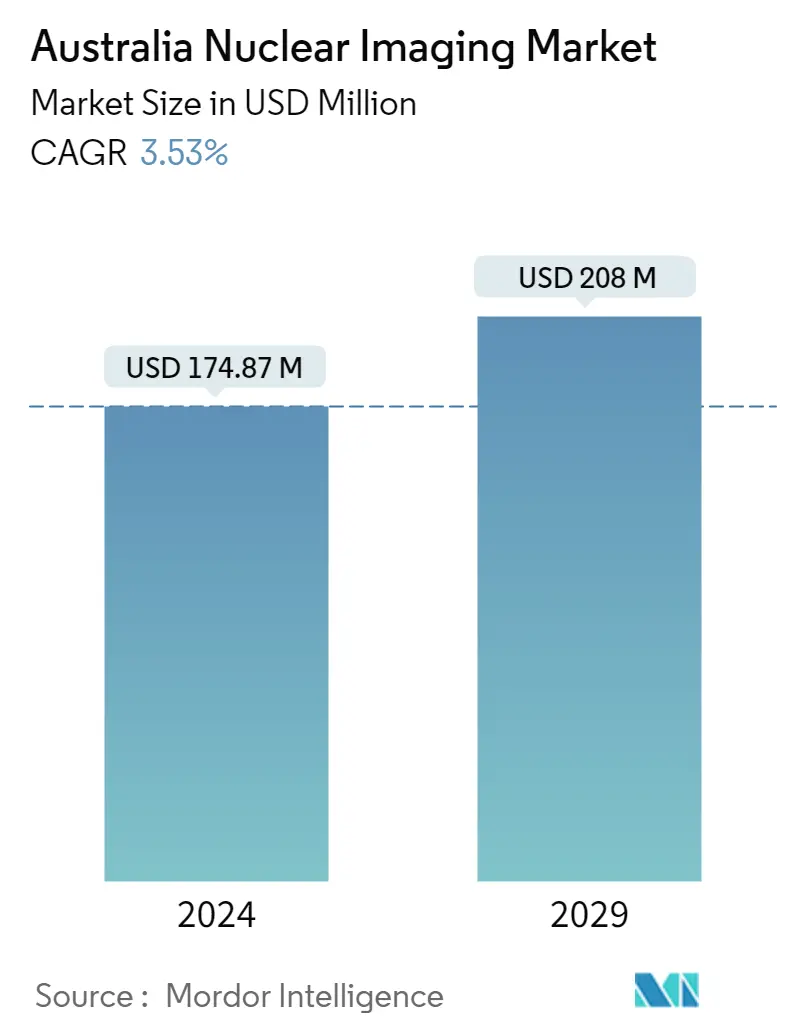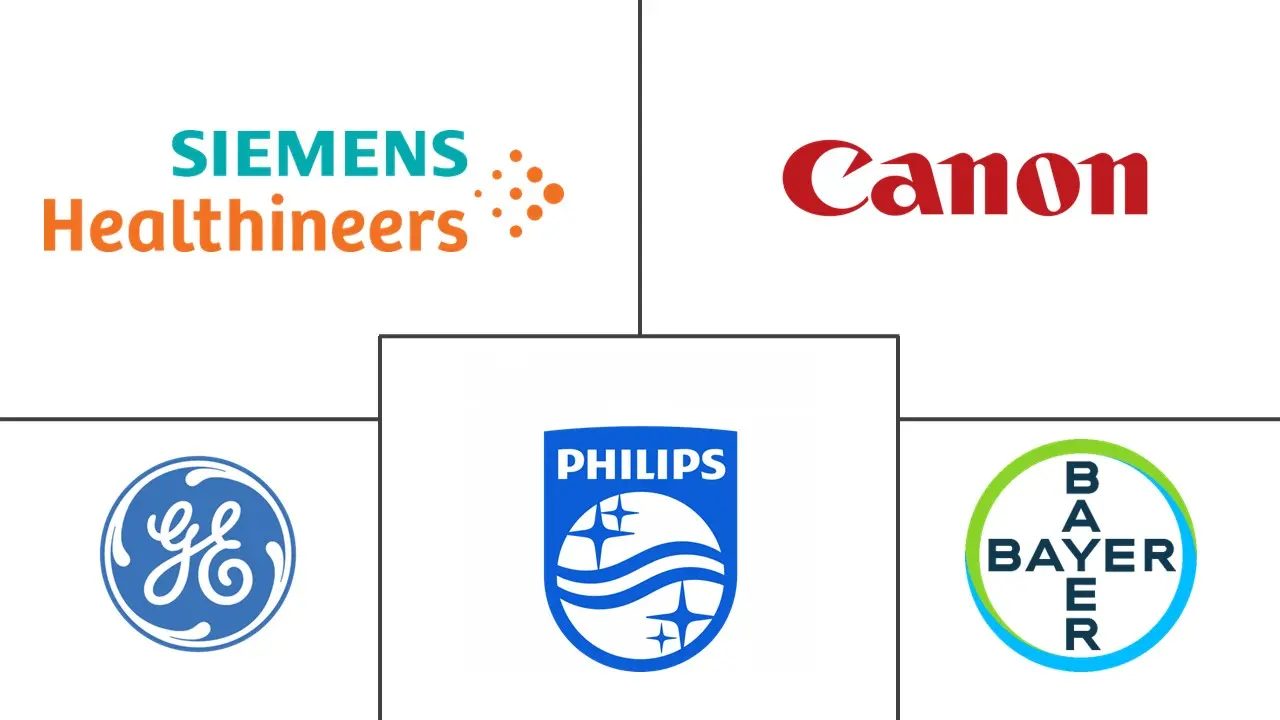Market Size of Australia Nuclear Imaging Industry

| Study Period | 2019 - 2029 |
| Base Year For Estimation | 2023 |
| Market Size (2024) | USD 174.87 Million |
| Market Size (2029) | USD 208.00 Million |
| CAGR (2024 - 2029) | 3.53 % |
| Market Concentration | Medium |
Major Players
*Disclaimer: Major Players sorted in no particular order |
Australia Nuclear Imaging Market Analysis
The Australia Nuclear Imaging Market size is estimated at USD 174.87 million in 2024, and is expected to reach USD 208 million by 2029, growing at a CAGR of 3.53% during the forecast period (2024-2029).
The COVID-19 pandemic had a significant impact on the nuclear imaging market in Australia. Various research studies have been published to provide insight into the effects of the pandemic on the studied market. The impact of the COVID-19 pandemic on diagnostic imaging services in Australia, according to research released in July 2020 titled "COVID-19 impact on nuclear medicine: an Australian perspective", showed that nuclear medicine and CT services were relatively less affected than general radiography, ultrasound, and MRI services. Nuclear medicine services were provided less frequently in March 2020 (down 10.1%), April 2020 (down 24.6%), and May 2020 (down 12.3%), with June 2020 (up 11.0%) seeing a notable increase. The country had a severe shortfall in the supply of radiopharmaceuticals during the COVID-19 outbreak, which is anticipated to impede market expansion. A batch of nuclear medicine generators failed the quality check in October 2020, according to an announcement from the Australian Nuclear Science and Technology Organization (ANSTO), which caused a temporary bottleneck in supply. Thus, the market is adversely affected by the pandemic. However, the pending cases are expected to undergo treatment which is expected to increase the market growth in the future.
Technological improvements, expanding diagnostic applications in various diseases such as neurology disorders, government assistance, and the transition from standalone to hybrid modalities are all factors driving the market's growth in Australia. In 2020, Dementia Australia estimates that 459,000 Australians will be affected by dementia. Dementia Australia predicted that by 2058, there will be 1.1 million persons in the world who have dementia. It was the second leading cause of mortality in Australia, the main cause of death for Australian women, and Dementia Australia predicts that it will overtake all other causes of death within the next few years. There is projected to be a significant demand for an accurate diagnosis of the disease given the vast number of people in Germany who live with dementia-related conditions. Since SPECT imaging can be used for the diagnosis of dementia, there is likely to be a demand for this application in the forecast period.
The Appropriate Use Criteria for PSMA PET Imaging were published in September 2021 by the Australia and New Zealand Society of Nuclear Medicine (ANZSNM) and The Society of Nuclear Medicine and Molecular Imaging (SNMMI). These criteria will be a useful resource for doctors as they choose the most appropriate diagnostic strategy for their patients. Such programs and government assistance will expand Australia's nuclear medical market. Additionally, OncoBeta GmbH, a commercial-stage medical device firm focused on cutting-edge epidermal radioisotope therapy, and the Australian Nuclear Science and Technology Organization established manufacturing cooperation in July 2021. (ANSTO). As part of this, ANSTO will create OncoBeta's cutting-edge Rhenium-SCT therapy, which will be made available by the end of 2021 for the treatment of non-melanoma skin cancer. This will provide a brand-new, very effective therapy alternative to relieve the significant medical burden in Australia. Consequently, nuclear imaging is expanding in Australia. Thus, these factors are likely to increase market growth.
However, the lack of proper reimbursement and stringent regulatory approval procedures, and the high cost of equipment, are expected to impede the market growth in Australia.
Australia Nuclear Imaging Industry Segmentation
As per the scope of the report, nuclear medicine imaging procedures are non-invasive, with the exception of intravenous injections, and are usually painless medical tests that help physicians diagnose and evaluate medical conditions. These imaging scans use radioactive materials called radiopharmaceuticals or radiotracers. These radiopharmaceuticals are used in diagnosis and therapeutics. They are small substances that contain a radioactive substance that is used in the treatment of cancer, cardiac and neurological disorders. Australia Nuclear Imaging Market is segmented by Product (Equipment, and Diagnostic Radioisotope (SPECT Radioisotopes, and PET Radioisotopes), Application (SPECT Application (Cardiology, Neurology, Thyroid, and Other SPECT Applications), and PET Application (Oncology, Cardiology, Neurology, and Other PET Applications). The report offers the value (in USD million) for the above segments.
| By Product | ||||
| Equipment | ||||
|
| By Application | ||||||
| ||||||
|
Australia Nuclear Imaging Market Size Summary
The Australia nuclear imaging market is poised for growth, driven by technological advancements and expanding diagnostic applications, particularly in neurology and oncology. The market's expansion is supported by government initiatives and the transition from standalone to hybrid imaging modalities. Despite the challenges posed by the COVID-19 pandemic, which temporarily affected the supply of radiopharmaceuticals and service delivery, the market is expected to recover and grow. The demand for accurate diagnostic tools, especially for dementia-related conditions, is anticipated to boost the use of SPECT imaging. Additionally, collaborations such as those between OncoBeta GmbH and the Australian Nuclear Science and Technology Organization are set to introduce innovative therapies, further propelling market growth.
However, the market faces obstacles, including high equipment costs, stringent regulatory approvals, and inadequate reimbursement frameworks. Despite these challenges, the increasing prevalence of diseases requiring nuclear imaging and the growing number of diagnostic procedures are key drivers of market growth. The introduction of advanced PET scanners and digital diagnostic solutions is expected to enhance Australia's biomedical imaging capabilities. The market is moderately competitive, with major players like GE Healthcare, Siemens Healthineers AG, and Koninklijke Philips NV leading the charge. Strategic partnerships and technological innovations are likely to continue shaping the market landscape in the coming years.
Australia Nuclear Imaging Market Size - Table of Contents
-
1. MARKET DYNAMICS
-
1.1 Market Overview
-
1.2 Market Drivers
-
1.2.1 Increasing Prevalence of Chronic Diseases
-
1.2.2 Rising Geriatric Population
-
1.2.3 Increasing Technological Advancements
-
-
1.3 Market Restraints
-
1.3.1 Lack Of Proper Reimbursement And Stringent Regulatory Approval Procedures
-
1.3.2 High Cost of Equipment
-
-
1.4 Porter's Five Force Analysis
-
1.4.1 Threat of New Entrants
-
1.4.2 Bargaining Power of Buyers/Consumers
-
1.4.3 Bargaining Power of Suppliers
-
1.4.4 Threat of Substitute Products
-
1.4.5 Intensity of Competitive Rivalry
-
-
-
2. MARKET SEGMENTATION (Market Size by Value - USD million)
-
2.1 By Product
-
2.1.1 Equipment
-
2.1.2 Diagnostic Radioisotope
-
2.1.2.1 SPECT Radioisotopes
-
2.1.2.2 PET Radioisotopes
-
-
-
2.2 By Application
-
2.2.1 SPECT Application
-
2.2.1.1 Cardiology
-
2.2.1.2 Neurology
-
2.2.1.3 Thyroid
-
2.2.1.4 Other SPECT Applications
-
-
2.2.2 PET Application
-
2.2.2.1 Oncology
-
2.2.2.2 Cardiology
-
2.2.2.3 Neurology
-
2.2.2.4 Other PET Applications
-
-
-
Australia Nuclear Imaging Market Size FAQs
How big is the Australia Nuclear Imaging Market?
The Australia Nuclear Imaging Market size is expected to reach USD 174.87 million in 2024 and grow at a CAGR of 3.53% to reach USD 208.00 million by 2029.
What is the current Australia Nuclear Imaging Market size?
In 2024, the Australia Nuclear Imaging Market size is expected to reach USD 174.87 million.

